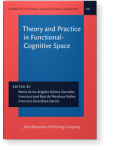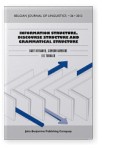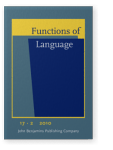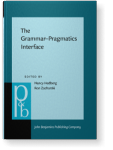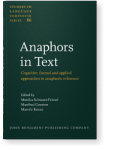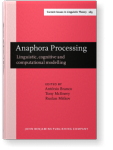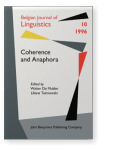Francis Cornish
List of John Benjamins publications for which Francis Cornish plays a role.
2014 "Agreement" as a perspectivizing device in discourse: The view from French Theory and Practice in Functional-Cognitive Space, Gómez González, María de los Ángeles, Francisco José Ruiz de Mendoza Ibáñez and Francisco Gonzálvez-García (eds.), pp. 177–202 | Article
The description of agreement brings into play a number of different components
and levels of analysis. This chapter’s goal is to show how stating certain
agreement facts requires reference to each of the levels and components available
within the Functional Discourse Grammar model. Agreement’s… read more
2012 Micro-syntax, macro-syntax, foregrounding and backgrounding in discourse: When indexicals target discursively subsidiary information Information Structure, Discourse Structure and Grammatical Structure, Defrancq, Bart, Gudrun Rawoens and Els Tobback (eds.), pp. 6–34 | Article
Adopting Berrendonner’s (1990, 2002) and Berrendonner et al.’s (forthcoming) distinction between “micro-syntax” and “macro-syntax”, as well as the orthogonal dichotomy between foregrounded and backgrounded discourse segments (cf. Khalil 2005), this paper aims to examine certain “non-canonical”… read more
2010 Anaphora: Text-based or discourse-dependent? Functionalist vs. formalist accounts Functions of Language 17:2, pp. 207–241 | Article
The traditional definition of anaphora in purely co-textual terms as a relation between two co-occurring expressions is in wide currency in theoretical and descriptive studies of the phenomenon. Indeed, it is currently adopted in on-line psycholinguistic experiments on the interpretation of… read more
2007 Implicit internal arguments, event structure, predication and anaphoric reference The Grammar–Pragmatics Interface: Essays in honor of Jeanette K. Gundel, Hedberg, Nancy and Ron Zacharski (eds.), pp. 189–216 | Article
2007 Indirect pronominal anaphora in English and French: Marginal rarity, or unmarked norm? Some psycholinguistic evidence Anaphors in Text: Cognitive, formal and applied approaches to anaphoric reference, Schwarz-Friesel, Monika, Manfred Consten and Mareile Knees (eds.), pp. 21–36 | Article
While for certain linguists (e.g. Erkü & Gundel, 1987) and psycholinguists (e.g. Sanford et al., 1983), using unaccented third person pronouns to refer to implicit referents is impossible or highly marked, for other linguists (e.g. Yule, 1982) and psycholinguists (e.g. Greene et al., 1994), this is… read more
2005 Degrees of Indirectness: Two Types of Implicit Referents and their Retrieval via Unaccented Pronouns Anaphora Processing: Linguistic, cognitive and computational modelling, Branco, António, Tony McEnery and Ruslan Mitkov (eds.), pp. 199–220 | Article
1996 Coherence: The lifeblood of anaphora Coherence and Anaphora, De Mulder, Walter and Liliane Tasmowski (eds.), pp. 37–54 | Article
Abstract. Coherence, which is an interpretative principle utilised by cooperative speakers/writers and hearers/readers, should not be confused with cohesion. Cohesion markers are not strictly necessary for the achievement of a coherent interpretation of a fragment of text, relative to some… read more
